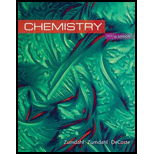
Ammonia and potassium iodide solutions are added to an aqueous solution of Cr(NO3)3. A solid is isolated (compound A), and the following data are collected:
i. When 0.105 g of compound A was strongly heated in excess 0 2, 0.0203 g CrO3 was formed.
ii. In a second experiment it took 32.93 mL of 0.100 M HCI to titrate completely the NH3 present in 0.341 g compound A.
iii. Compound A was found to contain 73.53% iodine by mass.
iv. The freezing point of water was lowered by 0.64°C when 0.601 g compound A was dissolved in 10.00 g H2O (Kf =1.86°C·kg/mol).
What is the formula of the compound? What is the structure of the complex ion present? (Hints: Cr3+ is expected to be sixcoordinate, with NH3 and possibly I− as ligands. The I− ions will be the counterions if needed.)
Interpretation: The formation of compound A by the addition of ammonia and potassium iodide solutions to an aqueous solution of
Concept introduction: Electronic configuration is used to describe the distribution of the electrons in the orbitals of an atom. Structure of an atom can be defined by its electronic configuration. It can also be used to denote an atom which is ionized to a cation or anion formed by the loss or gain of electrons in their respective orbitals.
To determine: The formula of the compound A and the structure of complex ion present on the basis of given information.
Answer to Problem 107IP
Answer
The formula of the compound is
Explanation of Solution
Explanation
The mass percent of
The molar mass of
The molar mass of
In
In
Mass percent of
The mass of compound A is
The mass of
Substitute the value of mass of compound A and
The mass percent of
One
Therefore,
Molar mass of
One
Therefore, the mass of
Mass percent of
The mass of compound A is this case is
The mass of
Substitute the value of mass of compound A and mass of
Except chromium, ammonia and iodine, no other element is needed in compound A.
Given
The mass percent of iodine is
To check whether any other element is needed or not, mass percent of
Substitute the values of mass percent in the above formula.
Therefore, no other element is required in the compound A.
The number of moles of
The compound A is assumed to have mass
The number of moles is calculated by the formula,
One mole of
Therefore, number of moles of
One mole of
Therefore, number of moles of
One mole of iodine have mass
Therefore, number of moles of iodine having mass
The formula of the compound is
Each molar amount is divided by lowest molar amount for calculating the empirical formula.
The lowest molar amount is
The number of
Number of moles of
The number of
Number of moles of
The number of iodine ligands is calculated by the formula,
Number of moles of iodine is
This indicates that the empirical formula is
Conclusion
The formula of the compound is
Want to see more full solutions like this?
Chapter 21 Solutions
Chemistry
- a. In the absorption spectrum of the complex ion Cr(NCS)63, there is a band corresponding to the absorption of a photon of light with an energy of 1.75 104 cm-1. Given 1 cm1 = 1.986 1023 J, what is the wavelength of this photon? b. The CrNC bond angle in Cr(NCS)63 is predicted to be 180. What is the hybridization of the N atom in the Ncs- ligand when a Lewis acid-base reaction occurs between Cr3+ and NCs- that would give a 180 CrNC bond angle? Cr(NCS)63 undergoes substitution by ethylenediamine (en) according to the equation Cr(NCS)63+2enCr(NCS)2(en)2++4NCS Does Cr(NCS)2(en)2+ exhibit geometric isomerism? Does Cr(NCS)2(en)2+ exhibit optical isomerism?arrow_forwardOne of the following nitrogen compounds or ions is not capable of serving as a ligand: NH4+, NH3, NH2. Identify this species, and explain your answer.arrow_forward
 ChemistryChemistryISBN:9781305957404Author:Steven S. Zumdahl, Susan A. Zumdahl, Donald J. DeCostePublisher:Cengage Learning
ChemistryChemistryISBN:9781305957404Author:Steven S. Zumdahl, Susan A. Zumdahl, Donald J. DeCostePublisher:Cengage Learning
 Chemistry: An Atoms First ApproachChemistryISBN:9781305079243Author:Steven S. Zumdahl, Susan A. ZumdahlPublisher:Cengage Learning
Chemistry: An Atoms First ApproachChemistryISBN:9781305079243Author:Steven S. Zumdahl, Susan A. ZumdahlPublisher:Cengage Learning Principles of Modern ChemistryChemistryISBN:9781305079113Author:David W. Oxtoby, H. Pat Gillis, Laurie J. ButlerPublisher:Cengage Learning
Principles of Modern ChemistryChemistryISBN:9781305079113Author:David W. Oxtoby, H. Pat Gillis, Laurie J. ButlerPublisher:Cengage Learning Chemistry & Chemical ReactivityChemistryISBN:9781337399074Author:John C. Kotz, Paul M. Treichel, John Townsend, David TreichelPublisher:Cengage Learning
Chemistry & Chemical ReactivityChemistryISBN:9781337399074Author:John C. Kotz, Paul M. Treichel, John Townsend, David TreichelPublisher:Cengage Learning





